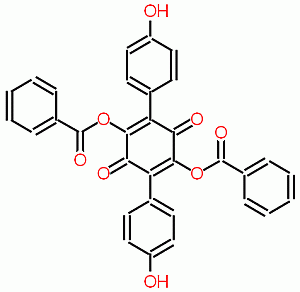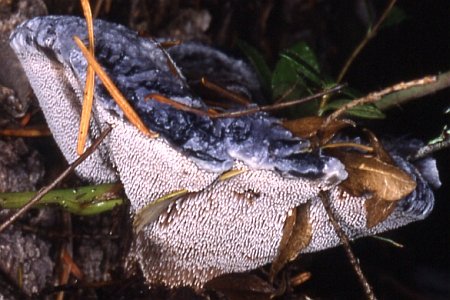The blue-green hydnellum, Hydnellum caeruleum (Hornem.) P. Karst.
Classification
Kingdom Fungi
Phylum Basidiomycota
Class Basidiomycetes
Order Thelephorales
Family Bankeraceae
Genus Hydnellum
Synonyms
Calodon caeruleus (Hornem.) P. Karst.
Bidr. Känn. Finl. Nat. Folk 37: 106 (1882)
Calodon cyaneotinctus (Peck) Snell
Mycologia 37: 51 (1945)
Calodon ferrugipes (Coker) Snell
Mycologia 37: 48 (1945)
Hydnellum alachuanum (Murrill) Coker & Beers
The stipitate hydnums of the eastern United States: 66 (1951)
Hydnellum cyaneotinctum (Peck) Banker
Mem. Torrey bot. Club 12: 164 (1906)
Hydnellum ferrugipes Coker
J. Elisha Mitchell scient. Soc. 34: 188 (1919)
Hydnellum inquinatum Banker
Mycologia 5(6): 202 (1913)
Hydnum alachuanum (Murrill) Murrill
Bull. Torrey bot. Club 67: 281 (1940)
Hydnum caeruleum Hornem.
Mycol. eur. (Erlanga) 2: 162 (1825)
Hydnum cyaneotinctum Peck
Bull. Torrey bot. Club 30: 98 (1903)
Hydnum suaveolens var. caeruleum (Hornem.) Fr.
Epicr. syst. mycol. (Upsaliae): 507 (1838)
Sarcodon alachuanus Murrill [as ‘alachuanum‘]
Bull. Torrey bot. Club 67: 275 (1940)
Common names
Blue-green hydnellum
Blue corky spine fungus
Blue spine
Blue tooth
Blauwgestreepte stekelzwam (Dutch)
Hydne bleu d’azur (French)
Blauer Korkstacheling (German)
Jelenkovka modrastá (Slovak)

My name is Austin Collins.
I've dedicated my life to Mushrooms.
I believe Mushrooms are the best kept secret when it comes to health and well being.
For that reason, I would like to share a company with you that in my opinion makes the best mushroom products on the market.
The company is called Noomadic Herbals, my favorite supplement they make is called "Mushroom Total".
I take their products every day and they have helped me think better and have more energy. Give them a try.
-Austin
Description
Cap: 3-12 cm diameter, convex to plane, sometimes with a slight central depression, lobed, tomentose becoming matted or glabrous towards center, often pitted or colliculose, color highly variable depending on age (white, yellowish, brown, bruised areas grayish-violet to blackish blue or a mixture of these); flesh in two layers: spongy outer layer and tough and woody inner core; often engulfs substrate litter in fruiting body.
Stem: 2-9 cm high x 1-3 cm thick, central or off-center, cylindrical with a slightly bulbous base, tomentose below to matted or glabrous above, spongy subsurface layer, hard at center, concolorous.
Spines: up to 6 mm long, decurrent, crowded, white with blue tints when young, later brownish.
Spores: 4.5-7 x 3.5-5 µm, subglobose, brownish; ornamentation tuberculate, not prominent, rounded to flattened, non-amyloid.
Spore print: brown.
Odor and taste: farinaceous.
Edibility: inedible.
Habitat: solitary to gregarious or fasciculate, on grounds in coniferous woods; abundant in late summer and fall after heavy rains, especially under spruce or jack pine.
Chemical reactions: context tissue olive green in KOH or NH4OH.
Description modified and adapted from Baird and Khan (1986) and Arora (1990), p. 625.
Bioactive compounds
The terphenylquinones aurantiacin (Montfort et al., 1966; Sullivan et al., 1967), dihydroaurantiacin dibenzoate, and thelephorin have been isolated from the ether and chloroform extracts of H. caeruleum (Sullivan et al., 1967). Later investigation of the methanol extract of the fruiting bodies resulted in the isolation of six p-terphenyl derivatives named thelephantins I-N (Quang et al., 2004).

Medicinal properties
Antitumor effects
Polysaccharides extracted from the mycelial culture of H. caeruleum and administered intraperitoneally into white mice at a dosage of 300 mg/kg inhibited the growth of both Sarcoma 180 and Ehrlich solid cancers by 60% (Ohtsuka et al., 1973).
Links
Tom Volk’s Fungus of the Month
References
Arora, D. (1990).
Mushrooms demystified. (2nd ed.).
Berkeley: Ten speed press. 959 pp.
Baird RE, Khan SR.
The Stipitate Hydnums (Thelephoraceae) of Florida.
Brittonia. 1986 38(2):171-84.
Montfort ML, Tyler VE, Brady LR.
Isolation of aurantiacin from Hydnellum caeruleum.
J Pharm Sci. 1966 55(11):1300-2.
Pubmed
Ohtsuka S, Ueno S, Yoshikumi C, Hirose F, Ohmura Y, Wada T, Fujii T, Takahashi E.
Polysaccharides having an anticarcinogenic effect and a method of producing them from species of Basidiomycetes.
UK Patent 1331513, 26 September 1973.
Parfitt D, Martyn AA, Simpson D, Rogers HJ, Boddy L.
Molecular and morphological discrimination of stipitate hydnoids in the genera Hydnellum and Phellodon.
Mycol Res. 2007 111(7):761-77.
Quang, DN, Hashimoto, T, Hitaka, Y, Tanaka, M, Nukada, M, Yamamoto, I, Asakawa, Y.
Thelephantins I-N; p-terphenyl derivatives from the inedible mushroom Hydnellum caeruleum.
Phytochemistry. 2004 65(8):1179-84.
Pubmed
Sullivan G, Brady LR, Tyler, VE.
Occurrence and distribution of terphenylquinones in Hydnellum species.
Lloydia. 1967 30(1):84-90.



